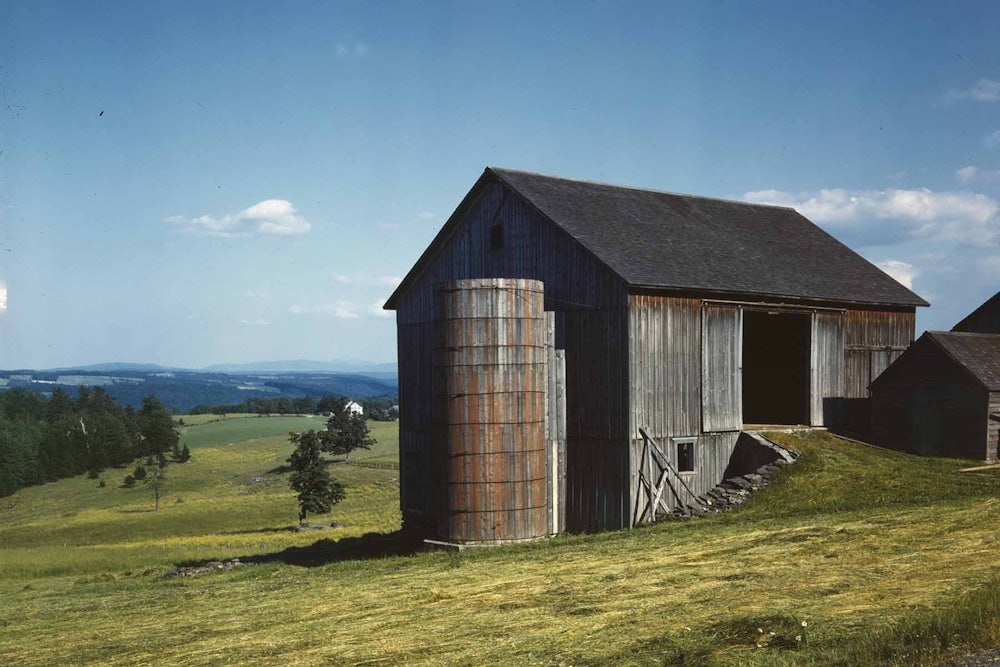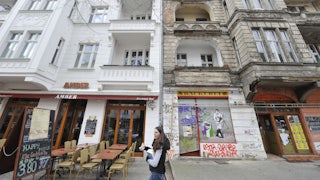A common story is told about idealistic city dwellers who move to rural areas like the Catskills. Over the centuries, rural New York state has played host to utopian groups seeking out new, radically communal ways of life. In the eighteenth and nineteenth centuries, groups like the Shakers and the Fourierists founded communities in Western New York. Later, in the Catskills, Buddhist monasteries were built and artists’ colonies like Byrdcliffe cropped up. In America, the quest for radical community—whether driven by religion, politics, or a desire to make art—has often been depicted as requiring a literal journey: a move from the city to the country, where it’s possible to build something new and start over.

This is broadly the story Adrian Shirk tells in her new book, Heaven is a Place on Earth: Searching for an American Utopia. A talented researcher and a sympathetic chronicler of intentional communities, Shirk visits a Bruderhof community in the foothills of the Catskills, where she finds men and women who dress like Mennonites, sing German folk songs, and support their “shared-purse economy” by manufacturing wooden toys and publishing books on theology. She tells of Father Divine and his Peace Mission Movement, which began in Harlem and then, during the Great Depression, spread upstate, where racially integrated “heavens” clustered around farms producing much-needed food. She relates the history of the Gate Hill Cooperative, an artists’ colony founded near Nyack, New York, in 1954 by a group of former Black Mountain College faculty that included John Cage and Merce Cunningham.
Yet Shirk’s book isn’t just a study of groups that have historically decamped to rural America with plans for a brave new world. Heaven is a Place on Earth is also a memoir, in which Shirk records her own search for a more communal life. When she starts her own utopian experiment, moving to upstate New York and buying a house in the Catskills—down the road from Delhi, New York, the small town where I grew up—the book becomes, unintentionally, a window into rural gentrification: the migration of affluent urbanites and suburbanites to the country. That she doesn’t see her move in these terms, at a time when second-home buyers have spurred a “freak-out housing market” in upstate New York, only highlights just how under-recognized rural gentrification is.
Shirk grew up in Portland, Oregon, and spent her college years in Brooklyn, where her interest in communal living began. Like many middle-class Americans, Shirk experienced college as a place of freedom and discovery, where “one could live in a close community and see each other regularly and organically.” Unlike most college students, Shirk and her friends founded a small press, took in “strays and travelers,” and hosted a biweekly reading. After college, Shirk was distressed to find herself socially isolated, with “wage-earning” at the center of her life. What Shirk is “questing after,” she writes, is “to not have to work as much, not have to have a career, and to be around people I like more often, and more easily.”
Rural living is not, however, her first choice. Midway through the book, she’s been dreaming of moving upstate, but when asked to imagine her “ideal commune,” she decides she doesn’t “need a view, or a mountain, or access to ‘nature’” and imagines instead a “cooperatively owned apartment building” in an outer borough. There’s only one problem with this scenario, Shirk admits: She and her friends would be “gentrifying a neighborhood”—or, if they bought somewhere more expensive, they’d “have to work waged labor all the time just to make their commune run.” This, it seems, is the logic that leads Shirk upstate: It’ll be more affordable than Brooklyn or the Bronx, and it won’t count as gentrification.
Why wouldn’t it count? When we talk about gentrification, we tend to talk about cities: New York, San Francisco, New Orleans. These are a few of the places examined by journalist P.E. Moskowitz in their 2017 book How to Kill a City: Gentrification, Inequality, and the Fight for the Neighborhood. “There seemed to be two worlds living on top of each other,” Moskowitz writes of New York City. “A set of stores, bars, and restaurants visited by me and my friends, and a set visited by the residents there before us.” But gentrification also happens in the country. In fact, Moskowitz’s image of “two worlds” describes perfectly what has happened in Delhi, a village of approximately 3,000 people that was once a farming community. Across the street from Tractor Supply, you can now buy a handmade lamp for more than $1,000. Next door to Dubben Brothers Hardware, you can buy a vintage rug for $2,500. At Bushel—a “collective dedicated to art, agriculture, ecology, and action”—a recent pop-up salon offered $125 haircuts, across the street from Cut Loose, where a haircut costs $15.
On some level, Shirk seems aware that migrating upstate might count as gentrification, but she takes pains not to fully acknowledge this fact. In a brief history of the Catskills, she notes that the region has “been continuously under gentry speculation in lifestyle and travel rags from the nineteenth century to today,” framing the issue as a historical fact—even an inevitability. Shirk notes that The New York Times has declared that the Catskills are having a “comeback” with “aging millennial hipsters”—“among whom,” Shirk writes, “I suppose we were counted.” Then the paragraph ends. Shirk counts herself, perhaps noting the irony, as one of these hipsters, but she does not consider what the effects of this hipster migration might be.
Once she’s upstate, she fails to see the two worlds in the Catskills. This seems self-protective: If she acknowledged them, she would have to reckon with her own decision. When Shirk visits Main Street in Delhi, she highlights Bushel—the nonprofit with the $125 haircuts—and dutifully quotes its mission statement about “growing community,” but doesn’t mention the high-end businesses down the block. Later, Shirk grabs drinks in Hobart at the “Bull & Garland pub,” which is not, as readers might assume, a bare-bones local spot—that would be the Dinner Plate, across the street, which serves potato skins, chicken tenders, and jalapeno poppers. The Bull & Garland is owned by British expats and serves duck confit. (Read more about it in Forbes, Vogue, and Time Out New York.)
When Shirk visits the “1860s farmhouse” that she and her husband will eventually purchase, she reveals the house’s price only after listing amenities: five bedrooms, “sixty-four acres of hardwood forest and fallow dairy pasture and apple orchards,” two spring-fed ponds, a two-story garage with potential for an apartment. How much, for all this? “Two hundred eighty-two thousand dollars,” Shirk writes. Appearing, as it does, at the end of a paragraph, the price seems intended to floor us: What a deal, the reader is supposed to be thinking. What Shirk doesn’t say is that the price only seems like a deal if you’re coming from New York City. In Delaware County, where Shirk looks at real estate, the median per-capita income is a little less than $28,000. To Shirk—and to many of her readers—$282,000 might seem like a steal. To the family of four who live down the road from Shirk’s compound, on $50,000 a year, the price might seem criminal. Shirk doesn’t reflect on what the existence of the second-home market might mean or how rising housing prices might impact working-class locals.
/ In honor of Earth Day, TNR’s climate coverage is free to registered users until April 29. Start reading now.
When Shirk tours the house, she makes sure to tell us she’s buying from a second-home owner, a “retired Ford engineer.” Why mention this? Perhaps because it exonerates Shirk from gentrification’s cardinal sin: If she buys from a second-home owner, she won’t have displaced anybody directly. Buying from a second-home owner has other benefits, too. The house has been “lovingly and expertly cared for,” and Shirk admires the “wild meadow and forest land, left to do its own thing.” The engineer and his wife, Shirk reports approvingly, “saw [themselves] as stewards of a kind of land preserve.” And sure, this is admirable. But treating your 64 acres like a nature preserve is also its own kind of privilege, available only to those who don’t need the land to make their living. Shirk doesn’t pause on this or on the run-down farms and ranch houses and trailer parks in Delaware County, although many exist. When she hikes to the highest point of her soon-to-be property and savors the view, she reminds herself that “apprehending and idolizing a view relates to imperialism, manifest destiny, power, conquest.” Shirk interrupts her reverie to ruminate on abstractions, but she doesn’t grapple with the fact that, among the “leafy hills and peaks” she looks out on, there are many houses in worse shape than the former second home she’s preparing to purchase, and that there are people living in them.
Ultimately, it’s this blind spot—Shirk’s inability to see locals—that most troubles me. When Shirk conducts fieldwork, visiting The Farm in Tennessee or Black Mountain College in North Carolina, she talks to people and learns about these communities. In Delaware County, locals rarely warrant attention. Her neighbors make a brief, instrumental appearance: They tell Shirk the “entire and complete history” of her house. Otherwise, Shirk hangs out with a poet who lives in a “huge Victorian home” that is “gorgeous and simple.” Or Shirk invites up friends from the city—a professor on sabbatical, a producer for This American Life.
This depiction of Delaware County as a place that contains only urbanites is something Shirk’s book has in common with lifestyle writing on the Catskills, which appears, like clockwork, in the Travel and Real Estate sections of The New York Times. In older articles—say, “Vintage Homes and Postcard Panoramas,” from 2009—this blind spot is near absolute. Readers meet Lawrence Lewis, “Manhattan gemologist”; Zonder Kennedy, “a professional guitarist from Manhattan”; and the “designers, professors, musicians and doctors” who are renovating historic houses, “making up for decades of neglect.” It’s in this final clause that the locals appear, their presence only implied: tasteless simpletons who don’t appreciate “wide-plank floors, pocket doors, and eyebrow moldings” and have let the town’s “vintage homes” fall apart. In Times pieces written after the rise of Trump, the specter of the “white working class” is often present, but only superficially. A 2019 article on the “comeback” of the Catskills ends with a brief mention of the “socioeconomic divide” between locals and weekenders. “It’s still very poor,” says Victoria Wilson, a second-home owner, a senior editor at Knopf, and apparently the best source on rural poverty that the author could find.
These blind spots matter because they stifle an important conversation before it can start. Rural gentrification has consequences, and we should be talking about them. In the recent book Pushed Out: Contested Development and Rural Gentrification in the US West, the sociologist Ryanne Pilgeram highlights two negative effects: Rising housing prices push some residents out, and the residents who remain are increasingly surrounded by stores and services they cannot afford to access. To understand the changes in Dover, Idaho, her hometown, Pilgeram applies the concept of “amenity migration.” Retirees move to Dover for certain amenities—mountain views, recreational opportunities. Once amenity migrants arrive, more amenities pop up that cater to newcomers. Pilgeram articulates how these new amenities—even those that are purportedly public—can also exclude: In Dover, new bike trails are built, but most “old-timers” don’t cycle; slips at the new marina cost $1,000 per season, more than many locals can afford. The new housing development doesn’t have gates, but “the restructuring of space along class divisions has created its own kinds of gates and walls,” Pilgeram writes.
Writers like Shirk who take part in amenity migration should acknowledge these class divisions. Which isn’t to say acknowledgment is an end point: If Shirk had slotted in “rural gentrification” alongside “imperialism” in her litany at the top of the hill, this would have been something, but not much. To paraphrase Katy Waldman’s critique of self-awareness in contemporary fiction, awareness doesn’t equal atonement. But awareness is a first step. Only once we’re aware of rural gentrification can we talk about its effects and consider how to bridge the two worlds in the Catskills and areas like it.






